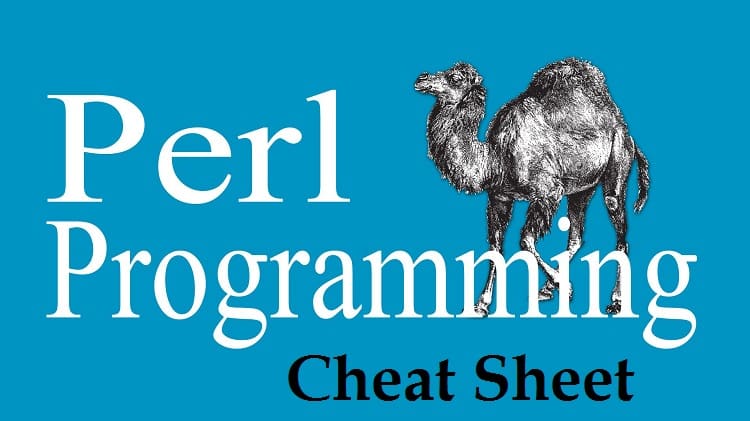Perl stands for practical extraction and report language. Perl is a high-level programming language mostly used for website designing. This language is useful for network programming, system administration, and bioinformatics. Using Perl programming language programmer can write a program easily, and understanding of this language is also easy for the programmer. You can easily embed Perl programming language into the system. Because of an interpreter, the system gets automatically updated. The Perl language also works with the HTML, XML, and other markup languages. The Perl cheat sheet provides a basic and advanced concept of Perl programming language. This Perl programming language cheat sheet is helpful for both beginners and professionals. You can find freelancers who know Perl, and you can also get certified freelancers for this language.
Basic Syntax of Perl
The basic syntax of the Perl programming language contains –e option at command line which allows running the Perl statement from a command line.
$perl -e ‘print “Hello World\n”‘
Data Types in Perl
As Perl does not have firm data types, you need not specify a type for your data. The interpreter of this language decides the type based on the context of the data itself. Following are the list of data types.
- Scalar: A $ sign precedes the scalar variable. The scalar is either number, string, and references.
- Array: The array is preceded by @ sign. The array is the sequential lists of scalars that you can access with a numeric index which starts with 0.
- Hashes: The hashes preceded by a % sign. The hashes are unordered sets of key/value pairs that are accessed using the keys as a subscript.
Variables in Perl
For storing the values of the variables, you find reserved memory location. When you create the variable, the space in the memory gets allocated for it. The Perl programming language uses the = sign for assignment of the value to the variable. For ex $ age=20.
Conditional Statements in Perl
Following are the types of conditional statements
- If Statement
if(boolean_expression) {
# statement(s) execute if condition is true
}
- If… else statement
if(boolean_expression) {
# statement(s) execute if the condition is true
} else {
# statement(s) execute if the condition is false
}
- Unless Statement
unless(boolean_expression) {
# statement(s) will execute if the given condition is false
}
- Unless else Statement
unless(boolean_expression) {
# statement(s) will execute if the given condition is false
} else {
# statement(s) will execute if the given condition is true
}
Loops in Perl
Following are the types of loop in Perl programming language
- While Loop
while(condition) {
statement(s);
}
- Until Loop
until(condition) {
statement(s);
}
- For Loop
for ( exp1; exp2; exp3 ) {
statement(s);
}
- For each
foreach var (list) {
…
}
- do…while statement
do {
statement(s);
}while( condition );
Operators in Perl Programming Language
Perl programming language has a rich set of operators. Operators are the symbols which tell the compiler to perform a particular operation. You can hire freelancers who work on Perl programming language. Following are the types of an operator in Perl programming language.
- Arithmetic Operators
- Equality Operators
- Logical Operators
- Assignment Operators
- Bitwise Operators
- Logical Operators
- Quote-like Operators
- Miscellaneous Operators
Perl Subroutine
Perl subroutine or function is a group of statements that together perform the task. Through subroutine, you can divide your program code. You can find freelancers who know Perl, and you also get certified freelancers for this language. Following are the syntax for a subroutine.
sub subroutine_name {
the body of the subroutine
}
Following is the way for calling the Perl programming
subroutine_name( list of arguments );
File Handling in Perl
Perl filehandles are capable of reading/write access so that you can read and update any device or file associated with filehandles.
open FILEHANDLE, EXPR
open FILEHANDLE
sysopen FILEHANDLE, FILENAME, MODE, PERMS
sysopen FILEHANDLE, FILENAME, MODE
Directories in Perl
Syntax for creation of directories
#!/usr/bin/perl
$dir = “/tmp/perl”;
# This creates perl directory in /tmp directory.
mkdir( $dir ) or die “Couldn’t create $dir directory, $!”;
print “Directory created successfully\n”;
Syntax for remove of directories
#!/usr/bin/perl
$dir = “/tmp/perl”;
# This removes perl directory from /tmp directory.
rmdir( $dir ) or die “Couldn’t remove $dir directory, $!”;
print “Directory removed successfully\n”;
Syntax For Change Directory
#!/usr/bin/perl
$dir = “/home”;
# This changes perl directory and moves you inside /home directory.
chdir( $dir ) or die “Couldn’t go inside $dir directory, $!”;
print “Your new location is $dir\n”;
Summary: This article is on the Perl programming cheat sheet which covers all the basic and advances syntax of the language. This cheat sheet is helpful for both beginner and professionals when they are performing the programming task in Perl programming language.

